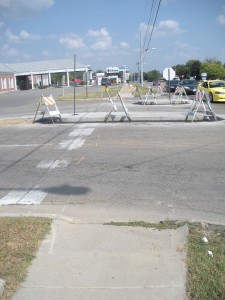 A clearer understanding of ADA design seems to be on the horizon. Today, the U.S. Access Board released a formal set of proposed guidelines for accessible rights-of-way, also known as PROWAG, at a public briefing and press conference. This document, once adopted, will finally provide the elusive guidance those of us in the design community have been looking for since the passage of the ADA in 1990. And with a better understanding of how to best design compliant infrastructure, we will be able to better construct improvements that increase accessibility and meet the terms of the law. Unlike the new construction shown in the photo to the left.
A clearer understanding of ADA design seems to be on the horizon. Today, the U.S. Access Board released a formal set of proposed guidelines for accessible rights-of-way, also known as PROWAG, at a public briefing and press conference. This document, once adopted, will finally provide the elusive guidance those of us in the design community have been looking for since the passage of the ADA in 1990. And with a better understanding of how to best design compliant infrastructure, we will be able to better construct improvements that increase accessibility and meet the terms of the law. Unlike the new construction shown in the photo to the left.
Those of you interested in reading through the document will find it embedded below or at the link to the guidelines in the paragraph above. Accessibility Online is also hosting a webinar on August 9, 2011, to provide information about the guidelines. According to their website, the webinar “will provide an overview of the NPRM, including major issues addressed in the notice such as alterations to existing facilities, existing facilities that are not altered, and allowances for typical roadway geometry. Time will be allotted for questions and answers.”
After reviewing the guidelines, you can submit any comments or suggestions before November 23, 2011, by following the directions at the beginning of the document. So far the main comment I will submit is based on something I heard at a seminar I attended at the Illinois DOT earlier this year. The presenters shared with us a requirement of providing a minimum 5% running slope for the curb ramp. This means ramps must now fit within a tight range of 5% to 8.33%. No one in the room could figure out why this was a requirement and less than 5% would be a problem. Design and construction of a curb ramp meeting all requirements is probably the most challenging and misunderstood element in the entire guideline so adding design restrictions without good reason exacerbates the problem. If there is a reason, then it is worth doing, but so far no one has provided one. I’d be interested to hear viewpoints on this requirement from others. Or if you want to share any other observations or information about the new guidelines or about accessible design in the right of way, feel free to comment below.




Leave a Reply
You must be logged in to post a comment.